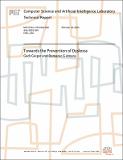| dc.contributor.author | Geiger, Gadi | |
| dc.contributor.author | Amara, Domenic G | |
| dc.date.accessioned | 2005-12-22T02:37:36Z | |
| dc.date.available | 2005-12-22T02:37:36Z | |
| dc.date.issued | 2005-10-18 | |
| dc.identifier.other | MIT-CSAIL-TR-2005-065 | |
| dc.identifier.other | AIM-2005-029 | |
| dc.identifier.other | CBCL-256 | |
| dc.identifier.uri | http://hdl.handle.net/1721.1/30575 | |
| dc.description.abstract | Previous studies have shown that dyslexic individuals who supplement windowed reading practice with intensive small-scale hand-eye coordination tasks exhibit marked improvement in their reading skills. Here we examine whether similar hand-eye coordination activities, in the form of artwork performed by children in kindergarten, first and second grades, could reduce the number of students at-risk for reading problems. Our results suggest that daily hand-eye coordination activities significantly reduce the number of students at-risk. We believe that the effectiveness of these activities derives from their ability to prepare the students perceptually for reading. | |
| dc.format.extent | 0 p. | |
| dc.format.extent | 14865502 bytes | |
| dc.format.extent | 6633149 bytes | |
| dc.format.mimetype | application/postscript | |
| dc.format.mimetype | application/pdf | |
| dc.language.iso | en_US | |
| dc.relation.ispartofseries | Massachusetts Institute of Technology Computer Science and Artificial Intelligence Laboratory | |
| dc.subject | AI | |
| dc.subject | dyslexia | |
| dc.subject | prevention | |
| dc.title | Towards the Prevention of Dyslexia | |
